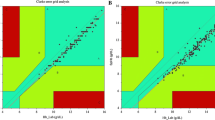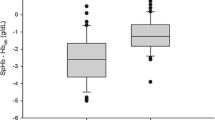Abstract
The decision to administer blood products is complex and multifactorial. Accurate assessment of the concentration of hemoglobin [Hgb] is a key component of this evaluation. Recently a noninvasive method of continuously measuring hemoglobin (SpHb) has become available with multi-wavelength Pulse CO-Oximetry. The accuracy of this device is well documented, but the trending ability of this monitor has not been previously described. Twenty patients undergoing major thoracic and lumbar spine surgery were recruited. All patients received radial arterial lines. On the contralateral index finger, a R1 25 sensor (Rev E) was applied and connected to a Radical-7 Pulse CO-Oximeter (both Masimo Corp, Irvine, CA). Blood samples were drawn intermittently at the anesthesia provider’s discretion and were analyzed by the operating room satellite laboratory CO-Oximeter. The value of Hgb and SpHb at that time point was compared. Trend analysis was performed by the four quadrant plot technique, testing directionality of change, and Critchley’s polar plot method testing both directionality and magnitude of the change in values. Eighty-eight samples recorded at times of sufficient signal quality were available for analysis. Four quadrant plot analysis revealed 94% of data within the quadrants associated with the correct direction change, and 90% of data points lay within the analysis bounds proposed by Critchley. Pulse CO-Oximetry offers an acceptable trend monitor in patients undergoing major spine surgery. Future work should explore the ability of this device to detect large changes in hemoglobin, as well as its applicability in additional surgical and non-surgical patient populations.




Similar content being viewed by others
References
Hahn RG, Li Y, Zdolsek J. Non-invasive monitoring of blood haemoglobin for analysis of fluid volume kinetics. Acta Anaesthesiol Scand. 2010;54(10):1233–40.
Macknet MR, Allard M, Applegate RL, Rook J. The accuracy of noninvasive and continuous total hemoglobin measurement by pulse CO-Oximetry in human subjects undergoing hemodilution. Anesth Analg. 2010;111(6):1424–6.
Causey MW, Miller S, Foster A, et al. Validation of noninvasive hemoglobin measurements using the Masimo Radical-7 SpHb Station. Am J Surg. 2011;201(5):592–8.
Frasca D, Dahyot-Fizelier C, Catherine K, et al. Accuracy of a continuous noninvasive hemoglobin monitor in intensive care unit patients. Crit Care Med. 2011;39(10):2277–82.
Gayat E, Bodin A, Sportiello C, et al. Performance evaluation of a noninvasive hemoglobin monitoring device. Ann Emerg Med. 2011;57(4):330–3.
Miller RD, Ward TA, Shiboski SC, Cohen NH. A comparison of three methods of hemoglobin monitoring in patients undergoing spine surgery. Anesth Analg. 2011;112(4):858–63.
Ruppel GL, Wilson HA, Gall VK, Hempkens JA. Multi-wavelength pulse oximeter is not suitable for adjusting D(LCO) measurements. Respir Care. 2011;56(8):1115–21.
Berkow L, Rotolo S, Mirski E. Continuous Noninvasive Hemoglobin Monitoring During Complex Spine Surgery. Analg: Anesth; 2011.
Nguyen B-V, Vincent J-L, Nowak E, et al. The accuracy of noninvasive hemoglobin measurement by multiwavelength pulse oximetry after cardiac surgery. Anesth Analg. 2011;113(5):1052–7.
Morey TE, Gravenstein N, Rice MJ. Let’s think clinically instead of mathematically about device accuracy. Anesth Analg. 2011;113(1):89–91.
Bland JM, Altman DG. Agreement between methods of measurement with multiple observations per individual. J Biopharm Stat. 2007;17(4):571–82.
Bland JM, Altman DG. Measuring agreement in method comparison studies. Stat Methods Med Res. 1999;8(2):135–60.
Critchley LA, Lee A, Ho AM-H. A critical review of the ability of continuous cardiac output monitors to measure trends in cardiac output. Anesth Analg. 2010;111(5):1180–92.
Perrino AC, Harris SN, Luther MA. Intraoperative determination of cardiac output using multiplane transesophageal echocardiography: a comparison to thermodilution. Anesthesiology. 1998;89(2):350–7.
Perrino AC, O’Connor T, Luther M. Transtracheal Doppler cardiac output monitoring: comparison to thermodilution during noncardiac surgery. Anesth Analg. 1994;78(6):1060–6.
Critchley LA, Yang XX, Lee A. Assessment of trending ability of cardiac output monitors by polar plot methodology. J Cardiothorac Vasc Anesth. 2011;25(3):536–46.
O’Reilly M. Response to Gayat et al. Ann Emerg Med. 2011;58(1):106–7.
Cannesson M, Le Manach Y, Hofer CK, et al. Assessing the diagnostic accuracy of pulse pressure variations for the prediction of fluid responsiveness: a “gray zone” approach. Anesthesiology. 2011;115(2):231–41.
Acknowledgments
Devices and disposables provided by Masimo Corporation. Personnel and other support exclusively provided from departmental sources.
Conflicts of interest
None.
Author information
Authors and Affiliations
Corresponding author
Rights and permissions
About this article
Cite this article
Colquhoun, D.A., Forkin, K.T., Durieux, M.E. et al. Ability of the Masimo pulse CO-Oximeter to detect changes in hemoglobin. J Clin Monit Comput 26, 69–73 (2012). https://doi.org/10.1007/s10877-012-9335-3
Received:
Accepted:
Published:
Issue Date:
DOI: https://doi.org/10.1007/s10877-012-9335-3




